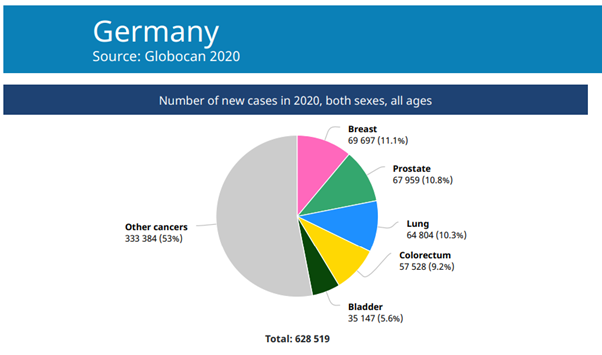Remote Patient Monitoring (RPM) has proven to be a cost-effective solution for managing chronic disease compared with usual care. Covid-19 accelerated the dramatic growth of the sector across the European continent (and worldwide).
The Pandemic now seems like a distant past, and the global adaptation of digital health systems that enable remote care seems to be one of the most positive incomes of it.
Remote care and monitoring of patients save medical staff from unnecessary risks and protect patients as well.
In this article, we will analyze the role of modern remote monitoring solutions in tracking the chronic conditions of German patients. We’ve chosen Germany as a country with a well-developed healthcare system that allows tracking patient data and is widely researched.
We’ll speculate on the role of remote monitoring in tracking and taming chronic conditions, will discuss RPM benefits, market state, and trends.
In the end, we’ll weigh all pros and cons of entering the healthcare software development and RPM software development market and the potential return on investments. But let’s figure out the benefits of remote patient monitoring first.
Benefits of Remote Patient Monitoring
Remote Patient Monitoring (RPM) solutions enable healthcare providers to remotely monitor the state of diseases and their symptoms, contact and interact with patients in a virtual environment, create healthcare plans, and educate patients on how to implement self-care when their condition changes.
RPM solutions can predict and prevent events by monitoring patients’ health and enabling remote consultations and interventions with clinicians.
The shift to remote healthcare was inevitable and often necessary due to the decreasing number of healthcare personnel in most EU territories. In other words, there are fewer general practitioners in Europe, particularly to ensure proper quality assurance of local primary healthcare for chronic diseases.
Among potential benefits of implementing RPM solutions are:
- Granted timely doctors’ intervention that guarantees better patient outcomes
- Improved treatment and self-management of health conditions
- Reduced costs of care services, and lower hospital bills
There are benefits of RPM solutions for specific conditions. Digital solutions have an established track record if we’re speaking of such conditions as heart diseases, sleep apnoea, musculoskeletal disorders, chronic respiratory diseases, chronic kidney disease, and diabetes.
To sum things up, RPM solutions provide access to advanced and timely medicine, improve the quality of treatment, save money, shorter treatment times and hospital stays, give better access to information for doctors and patients, and tame chronic diseases.
Patient Monitoring Industry Segments in Germany
Let’s focus more closely on the main topic of the article, which is exploring the market of RPM solutions in Germany. As we have established, RPM devices continually monitor patients’ vital parameters, including blood pressure and heart rate, and collect medical data using specialized software.
The Patient Monitoring Market in Germany has various segments that can be categorized by the type of device, application, or end-user.
Elinext is a software development provider that has been in the healthcare market for over 20 years. They have developed software for multiple European companies and delivered many RPM software products for various types of devices, across various healthcare sectors, for both patients and clinicians.
RPM device types include hemodynamic monitoring devices, neuromonitoring devices, cardiac monitoring devices, respiratory monitoring devices, and many other RPMs.
Hence, application areas are cardiology, neurology, respiratory, weight management, and other apps.
End-users of RPM devices (and software) are obvious: patients, hospitals, clinics, and other medical facilities and institutions.
The stats for the value of each segment are available in the report executed by Mordor Intelligence.
Germany Patient Monitoring Market Analysis
The Germany Patient Monitoring Market is a growing market. CAGR of 6.4% is expected during the next five years. The COVID-19 pandemic grants market growth.
It is connected with the increased demand for wearable devices as they allow contactless communication with medical specialists.
Regarding COVID-19, pulse oximetry has been found to be a practical method for determining whether patients require hospital treatment or can be remotely monitored at home for their oxygen levels.
The COVID-19 pandemic has impacted market growth, particularly the demand for respiratory monitoring, which increased significantly during the pandemic. As always, the rising burden of chronic diseases is connected to lifestyle changes and the growing preference for home and patient monitoring.
In the near future, the increasing prevalence of chronic diseases such as cardiovascular, cancer, diabetes, and neurodegenerative diseases among the population will lead to an increase in demand for patient monitoring systems.
This is supported by statistics. According to GLOBOCAN, there were more than 628,000 confirmed new cases in Germany.
Source: gco.iarc.fr
The Alzheimer’s Association states that more than 1.5 million people in Germany are living with Alzheimer’s disease.
Chronic diseases are, unfortunately, on the rise, and it is expected to increase the demand for patient monitoring devices. The devices are blood pressure machines, glucometers, and many others. Market growth is imminent. Commercialization and strengthening distribution channels commit to it. Sleep Analyzer is a device that can be used to detect sleep apnea. Smart Watch can track blood oxygen levels and heart rate. The affordability of devices is the factor that helps market growth.
Market Trends and Presence
22% of the population in Germany is aged 65 years and above in 2022. So to the rising burden of chronic disease, the rising geriatric population increases the demand for remote patient monitoring devices.
The implementation of RPM can improve the management of chronic diseases by measuring critical risk indicators such as heart rate, glucose levels, and other variables, and reacting accordingly.
We have listed various benefits of RPM, including the low cost of healthcare, a reduction in extended hospitalization, and fewer doctor appointments.
Perhaps the most significant reason to implement remote healthcare monitoring is to help reduce the costs associated with the treatment of chronic diseases.
Who are the key players in the market?
- Abbott Laboratories
- Boston Scientific Corporation
- GE Healthcare
- Johnson & Johnson
- Koninklijke Philips NV
- Siemens Healthcare GmbH.
The market in Germany cannot be called either fragmented or consolidated. It falls somewhere in the middle, not overrun by large enterprises, although they are definitely present (as seen from the list above).
Moreover, new products are being launched all the time. Germany’s patient monitoring market is mildly competitive, and some niches seem more promising than others.
If you want to compete with industry leaders, you may need a reliable software development partner. Elinext is one of the best options in the market, with a broad portfolio of completed projects in software development for RPM devices.
As we have established, there is expected growth in Germany over the forecast period, and the market looks like a sweet pie that everyone wants a piece of.
Companies are implementing strategic initiatives, including new mergers, product launches, acquisitions, and partnerships to gain marketing positions.
Regarding device launches, here are a couple of examples:
In September 2021, Withings launched a new smartwatch that includes a slew of heart-health monitoring features.
They include heart rate, ECG, breathing disturbances, blood oxygen levels, sleep, and physical activity tracking.
Users can identify heart rhythms, and ECG feature to help detect atrial fibrillation with this watch.
In March 2022, Infineon Technologies AG in collaboration with Sleepiz AG launched Infineon XENSIV 60 GHz radar technology, integrated into smart home and healthcare devices.
Healthcare apps with it allow you to accurately measure vital signs such as heartbeat and breathing rate without touching the body.
Conclusion
Remote Patient Monitoring (RPM) has proven to be a cost-effective solution for managing chronic diseases. The market in Germany is growing at an alarming pace due to the expected rate of chronic diseases. While big companies are present as players on the market, they have not overwhelmed it to date.
Entering the market now seems like a reliable option. As a potential investor, you may be interested in an RPM software developer that has experience in the German and other European markets. Elinext has a wealth of experience in this area. Contact us to get your free quote, and we will discuss our business opportunities.
Related Cases
Real-Time Fertility Lab Monitoring Project
Web App for IoT Devices Monitoring
Mobile Application for Brain Data Monitoring with BLE Device










